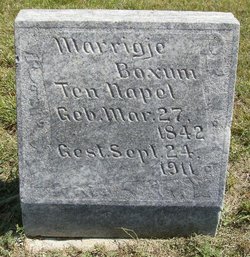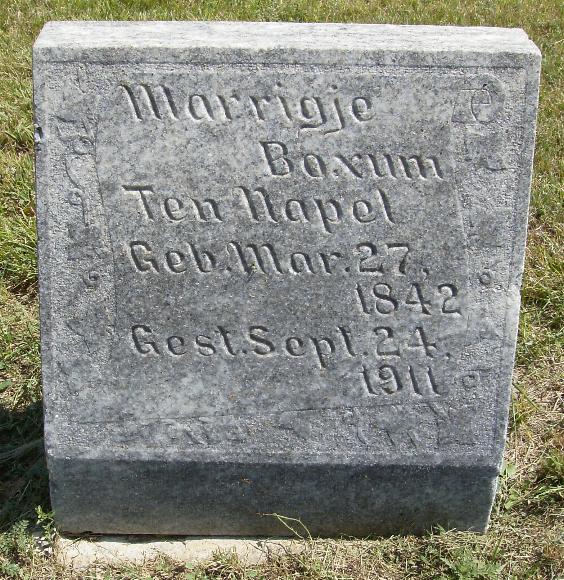On April 27, 1866 Marrigje ten Napel married in the municipality of Ambt Vollenhove at the age of 24 years the two years younger farmer Albert Boxum.
They had in municipality of Ambt Vollenhove the following eleven children:
* Hendrikje, born February 2, 1867;
* Marrigje, March 14, 1868;
* Harm, March 30, 1869;
* Jacobje, March 16, 1870;
* Evert, March 15, 1872;
* Jan, October 22, 1873;
* Hendrik, January 7, 1876;
* Grietje [Grace], December 10, 1877;
* Albert, January 1, 1880;
* Arrie [Harry], May 7, 1882;
* Annigje [Anna], March 15, 1884.
In March 1870, January 1876 and January 1880 the family Boxum lived in the neighborhoodship of Leeuwte in the municipality Ambt Vollenhove. In May 1882 and March 1884 they lived on the Kuinderdijk (= Kuinder's Dyke) in house number 39 in the neighborhoodship of Baarlo, also located in the municipality of Ambt Vollenhove. On August 29, 1885 Marrigje, her husband, the Dutch Reformed farmer Albert Boxum, and their eleven children moved from Baarlo to the nearby dyke village of Blankenham.
On October 10, 1895 Mrs Boxum (52 years old), her husband Albt. Boxum (51, farmer) and their seven children, Hend. (daughter, 28), Jacob[je] (daughter, 24), Hendrik (19), Grietje (17), Albt. (14), Arie (11 [has to be: 9]) and Annigje (9 [has to be: 11]) arrived on the ship The Majestic from Liverpool via Queenstown in Ireland at the port of New York, Ellis Island. Their destination was Cawker City, located along the north shore of Waconda Lake and Glen Elder State Park, Mitchell County, in the northern part of Kansas.
In June 1900 Mary (58 years old, born in March 1842 in Holland, immigrated in 1895, mother of 3 deceased and 8 living children), her husband Albert Boxum (56, September 1843, Holland, immigrated in 1895, farmer), their children Harm (31, March 1869, Holland, immigrated in 1892, farm laborer), Grace (22 December 1877, Holland, immigrated in 1895), Albert (20, January 1880, Holland, immigrated in 1895, farm laborer), Harry (18, May 1882, Holland, immigrated in 1895, farm laborer) and Anna (16, March 1884, Holland, immigrated in 1895), and her nephew John Everett (2, July 1897, Holland) were living on their own farm in Lincoln Township, Smith County, located north of Cawker City, in the extreme northern part of Kansas.
In March 1905 Mary (63), her husband Albert Boxum (62), and their children Albert (25), Herry (23) and Anna (20) were still living on their own farm in Lincoln Township, Smith County, Kansas.
Her husband Albert Boxum died in January 1908 at the age of 64 years in Smith County, Kansas. Widow Mary died in September 1911 at the age of 69 years in the unincorporated community of Dispatch, Smith County, Kansas.
Dispatch was a town founded on strong Dutch principles, in a place that many considered uninhabitable. The first Dutchmen arrived in 1869, and many began to follow their example,
arriving during the 1870s. At one time, the town was coined “The largest Dutch settlement in Kansas.” At its most successful, the town had two churches, a parsonage, a grocery store, a creamery, a post office, and a hardware store/gas station, where local families could have their cars worked on in later years. The town also had two separate cemeteries, located nearly a mile apart. When the Dutch settlers came to Dispatch, the first thing decided was that there would be a church. The Dutch Reformed Church was founded one mile east of Dispatch in 1871. This is the approximate location of the east cemetery. In 1872, a second group of Dutchmen split from this faction, and began their own church, calling themselves the Christian Reformed Church (CRC). The CRC, dedicated in 1917, is nowadays the only building still standing in Dispatch.
On April 27, 1866 Marrigje ten Napel married in the municipality of Ambt Vollenhove at the age of 24 years the two years younger farmer Albert Boxum.
They had in municipality of Ambt Vollenhove the following eleven children:
* Hendrikje, born February 2, 1867;
* Marrigje, March 14, 1868;
* Harm, March 30, 1869;
* Jacobje, March 16, 1870;
* Evert, March 15, 1872;
* Jan, October 22, 1873;
* Hendrik, January 7, 1876;
* Grietje [Grace], December 10, 1877;
* Albert, January 1, 1880;
* Arrie [Harry], May 7, 1882;
* Annigje [Anna], March 15, 1884.
In March 1870, January 1876 and January 1880 the family Boxum lived in the neighborhoodship of Leeuwte in the municipality Ambt Vollenhove. In May 1882 and March 1884 they lived on the Kuinderdijk (= Kuinder's Dyke) in house number 39 in the neighborhoodship of Baarlo, also located in the municipality of Ambt Vollenhove. On August 29, 1885 Marrigje, her husband, the Dutch Reformed farmer Albert Boxum, and their eleven children moved from Baarlo to the nearby dyke village of Blankenham.
On October 10, 1895 Mrs Boxum (52 years old), her husband Albt. Boxum (51, farmer) and their seven children, Hend. (daughter, 28), Jacob[je] (daughter, 24), Hendrik (19), Grietje (17), Albt. (14), Arie (11 [has to be: 9]) and Annigje (9 [has to be: 11]) arrived on the ship The Majestic from Liverpool via Queenstown in Ireland at the port of New York, Ellis Island. Their destination was Cawker City, located along the north shore of Waconda Lake and Glen Elder State Park, Mitchell County, in the northern part of Kansas.
In June 1900 Mary (58 years old, born in March 1842 in Holland, immigrated in 1895, mother of 3 deceased and 8 living children), her husband Albert Boxum (56, September 1843, Holland, immigrated in 1895, farmer), their children Harm (31, March 1869, Holland, immigrated in 1892, farm laborer), Grace (22 December 1877, Holland, immigrated in 1895), Albert (20, January 1880, Holland, immigrated in 1895, farm laborer), Harry (18, May 1882, Holland, immigrated in 1895, farm laborer) and Anna (16, March 1884, Holland, immigrated in 1895), and her nephew John Everett (2, July 1897, Holland) were living on their own farm in Lincoln Township, Smith County, located north of Cawker City, in the extreme northern part of Kansas.
In March 1905 Mary (63), her husband Albert Boxum (62), and their children Albert (25), Herry (23) and Anna (20) were still living on their own farm in Lincoln Township, Smith County, Kansas.
Her husband Albert Boxum died in January 1908 at the age of 64 years in Smith County, Kansas. Widow Mary died in September 1911 at the age of 69 years in the unincorporated community of Dispatch, Smith County, Kansas.
Dispatch was a town founded on strong Dutch principles, in a place that many considered uninhabitable. The first Dutchmen arrived in 1869, and many began to follow their example,
arriving during the 1870s. At one time, the town was coined “The largest Dutch settlement in Kansas.” At its most successful, the town had two churches, a parsonage, a grocery store, a creamery, a post office, and a hardware store/gas station, where local families could have their cars worked on in later years. The town also had two separate cemeteries, located nearly a mile apart. When the Dutch settlers came to Dispatch, the first thing decided was that there would be a church. The Dutch Reformed Church was founded one mile east of Dispatch in 1871. This is the approximate location of the east cemetery. In 1872, a second group of Dutchmen split from this faction, and began their own church, calling themselves the Christian Reformed Church (CRC). The CRC, dedicated in 1917, is nowadays the only building still standing in Dispatch.
Family Members
-
![]()
Hattie Boxum Van Laar
1867–1950
-
![]()
Marrigji Adriana "Mary" Boxum De Wit
1868–1951
-
![]()
Harm Boxum
1869–1944
-
![]()
Jacobje "Jacoba" Boxum Van Leeuwen
1870–1959
-
![]()
Jan Boxum
1873–1895
-
![]()
Hendrik "Henry" Boxum
1876–1894
-
![]()
Grace Boxum Veltkamp
1877–1963
-
![]()
Albert Boxum
1880–1923
-
![]()
Harry Boxum
1882–1958
-
![]()
Annigje "Anna" Boxum Voetberg
1884–1965
Sponsored by Ancestry
Advertisement
Advertisement













